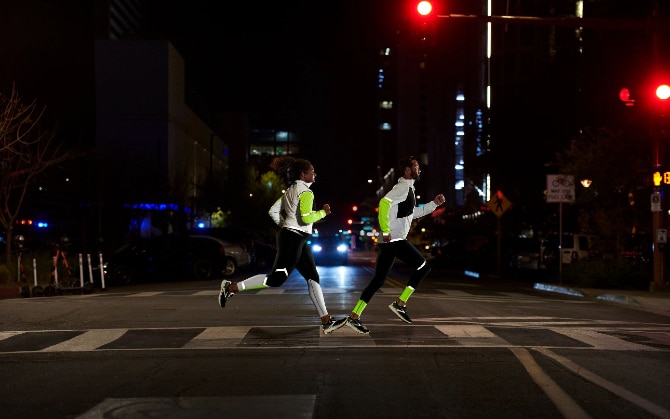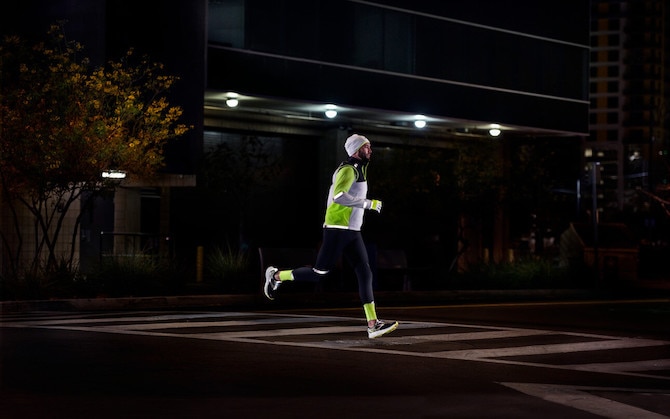How to stay safe and visible when running at night

One of the hardest parts of sticking to a running plan is simply finding the time each day. For those with busy schedules or young children at home, running at night may be the only realistic time to lace up. Others simply prefer to run at dawn or dusk. In this article, we'll go over some simple, effective tips to keep you visible, comfortable, and, most importantly, safe during your low-light runs.
In addition to schedule restrictions and personal preferences, running before or after the sun is up allows many runners in warmer areas to beat the brutal summer heat. In the darker, winter months, depending on where you are, it may be the only option if you work a 9-to-5 job. Running at night can be a ton of fun and exhilarating, especially when you are prepared and feel safe to do so.
Wear reflective and high-visibility gear.
While many running clothes and accessories will offer at least a hint of reflectivity, some apparel is specifically designed for nighttime, when it is important to be easily recognized as a runner. Many of these options are designed to include ample reflectivity in high-motion areas (shoulders, elbows, hips, and ankles) to give drivers clear recognition that you are a runner in motion, moving away from or toward them. Most gear includes reflective tape as well as high-visibility colours. In addition to reflective clothing and accessories, many running shoes will offer reflectivity on the heel, tongue, and upper toe box area.
Bring your phone.
While some runners enjoy bringing their phone to listen to music or track their mileage, others prefer to leave it all behind and break free from the digital world for a bit. When running at night or in an unfamiliar area, though, bringing your phone along is a great idea for additional safety. If you get lost, you can always use your phone's navigation app to find your way back home. And if you need to, you can immediately call someone for a ride.
Two related tips:
- Get to know your phone's safety features. Almost any smartphone, whether an iPhone or Android, will have an emergency safety feature to immediately alert emergency services, play a loud siren, or alert your emergency contacts of your location. Hopefully, you'll never need to use this feature, but it's a good idea to familiarize yourself with it.
- Skip the music. For nighttime runs, it is most safe to keep the music off and allow yourself to tune into your surroundings. You'll be able to hear vehicles in the area and other pedestrians nearby. In addition to the safety aspect, running at night or before the sun is up is often a quieter time, so this will give you the opportunity to listen to some of the natural sounds in your area you might otherwise miss.

Run in well-travelled, well-lit areas.
If you're running through town, choose one of the main streets with restaurants and stores. The main streets are generally more lit up and usually have people around. Often, streets nearer to a downtown area are better maintained and pose less of a hazard of tripping, too.
Run against traffic.
If you're running on roads without a sidewalk or running trail available, it is best to run against traffic, meaning on the left side of the street with traffic coming toward you. This may seem counter-intuitive at first, but it allows you to be more aware of your surroundings. You can get out of the way if need be or hop up onto the sidewalk when possible. When you're running toward traffic, you are also more visible to drivers on the road.
While everyone has their own comfort level when it comes to running at night, it's important to prepare enough so you feel fully confident before heading out. Wearing reflective gear is very important, and bringing your phone for added security and safety is highly recommended. Running in a familiar neighbourhood or through main areas in town is also a good idea. Whether you're a night owl or an early bird, following these tips will lead to safer, more visible runs.
Our writer's advice is intended for informational or general educational purposes only. We always encourage you to speak with your physician or healthcare provider before making any adjustments to your running, nutrition, or fitness routines.
